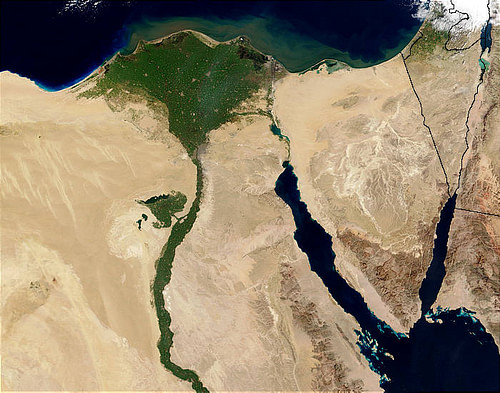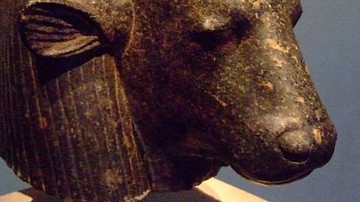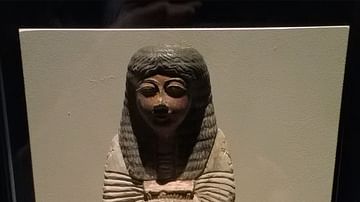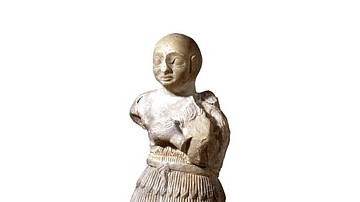
The world's longest river, located in Egypt, the Nile flows 4,132 miles (6,650 kilometres) northward to the Mediterranean Sea (a very unusual direction for a river to take). It was considered the source of life by the ancient Egyptians and has played a vital role in the country's history. The Nile flows from two separate sources: the White Nile from equatorial Africa and the Blue Nile from the Abyssinian highlands. The historian Waterson notes, "The Nile has played a vital part in the creation of Egypt, a process which started about five million years ago when the river began to flow northwards into Egypt" (7-8). Permanent settlements gradually rose along the banks of the river beginning c. 6000 BCE and this was the beginning of Egyptian civilization and culture which became the world's first recognizable nation state by c.3150 BCE. As the Nile River was seen as the source of all life, many of the most important myths of the Egyptians concern the Nile or make significant mention of it; among these is the story of Osiris, Isis, and Set and how order was established in the land.
The Nile in the Osiris Myth
Among the most popular tales in ancient Egypt concerning the Nile is that of the god Osiris and his betrayal and murder by his brother-god Set. Set was jealous of Osiris' power and popularity and so tricked him into laying down inside an elaborate coffin (sarcophagus) pretending he would give it as a gift to the one who fit into it the best. Once Osiris was inside, Set slammed the lid down and threw Osiris into the Nile River. Osiris' wife, Isis, went searching for her husband's body in order to give it proper burial and, after looking in many places, came upon some children playing by the Nile who told her where she could find the coffin. From this story comes the ancient belief of the Egyptians that children possessed the gift of divination as they were able to tell the goddess something which she could not discover herself.
The coffin floated down the Nile until it lodged in a tree at Byblos (in Phoenicia) which grew quickly around and enclosed it. The king of Byblos admired the strong, stout-looking tree and had it brought to his court and erected as a pillar. When Isis arrived at Byblos, in the course of her search, she recognized her husband's corpse was inside the tree and, after endearing herself to the king, requested the pillar as a favor. Isis then brought her dead husband back to Egypt to return him to life. This sequence of events would inspire the Djed column, a symbol which appears in Egyptian architecture and art throughout the history of the country, which symbolizes stability. The Djed, according to some interpretations, represents Osiris' backbone when he was encased in the tree or, according to others, the tree itself from which Isis removed Osiris' body to bring him back to life.
Once back in Egypt, Isis left Osiris in his coffin by the Nile to prepare the herbs and potions to bring him back to life. She left her sister, Nepthys, to guard the body from Set. Set, however, hearing that Isis had gone searching for Osiris, was looking for the body himself. He came upon Nepthys and forced her to tell him where his brother's body was hidden. Finding it, he hacked the corpse into pieces, and scattered them throughout Egypt. When Isis returned to revive her husband, Nepthys tearfully confessed what had happened and vowed to help her sister find out what Set had done with Osiris' body.
Isis and Nepthys went in search of Osiris' remains and, wherever they found a piece of him, they buried it according to the proper rituals and erected a shrine. This accounts for the many tombs of Osiris throughout ancient Egypt and was also said to have established the nomes, the thirty-six territorial divisions of ancient Egypt (similar to a county or province). Wherever a part of Osiris was buried, there a nome eventually grew up. She managed to find and bury every part of him except for his penis which Set had thrown into the Nile and which had been eaten by a crocodile. It is for this reason the crocodile came to be associated with the god of fertility, Sobek, and anyone eaten by a crocodile was considered fortunate in a happy death.
Since he was incomplete, Osiris could not return to life but became Lord of the Afterlife and Judge of the Dead. The Nile, which had received Osiris' penis, was made fertile because of this and gave life to the people of the land. Osiris' son, Horus, avenged his father by defeating Set and casting him out of the land (in some versions of the tale, killing him) and so restored balance and order to the region. Horus and Isis then ruled the land in harmony.
Importance to Egypt
Through this myth and others like it the Nile was held up to the ancient people as the source of all life in Egypt and an integral part of the lives of the gods. The Milky Way was considered a celestial mirror of the Nile and it was believed the sun god Ra drove his ship across it. The gods were intimately involved in the lives of the ancient Egyptians and it was believed that they caused the river's annual floods which deposited the fertile black soil along the arid banks. According to some myths, it was Isis who taught the people the skills of agriculture (in others, it is Osiris) and, in time, the people would develop canals, irrigation, and sophisticated systems to work the land. The Nile was also an important recreational resource for the Egyptians.
Besides swimming, the people enjoyed water jousting in which two-man teams in canoes, a `fighter' and a `rower', would compete trying to knock each other's fighter out of the boat. Another popular river sport was boat racing and displays of skill such as were described by the Roman playwright Seneca the Younger (1st century CE) who owned land in Egypt:
The people embark [on the Nile] on small boats, two to a boat, and one rows while the other bails out water. Then they are violently tossed about in the raging rapids. At length they reach the narrower channels and, swept along by the whole force of the river, they control the rushing boat by hand and plunge head downward to the great terror of the onlookers. You would believe sorrowfully that by now they were drowned and overwhelmed by such a mass of water, when far from the place where they fell, they shoot out as from a catapult, still sailing, and the subsiding wave does not submerge them, but carries them on to smooth waters.
The river became known as the “Father of Life” and the “Mother of All Men” and was considered a manifestation of the god Hapi, who blessed the land with life, as well as with the goddess Ma'at, who embodied the concepts of truth, harmony, and balance. The Nile was also linked to the ancient goddesses Hathor and, later, as noted, with Isis and Osiris. The god Khnum, who became the god of rebirth and creation in later dynasties, was originally the god of the source of the Nile who controlled its flow and sent the necessary yearly flood which the people depended on to fertilize the land.
Source of Life
During the reign of King Djoser (c. 2670 BCE) the land was struck with famine. Djoser had a dream in which the god Khnum came to him to complain that his shrine on the island of Elephantine in the river had fallen into disrepair and he was displeased at the neglect. Djoser's vizier, Imhotep, suggested the king travel to Elephantine to see whether the dream's message was true. Djoser found the temple shrine in poor condition and ordered it rebuilt and the complex around it renovated. Afterwards, the famine was lifted and Egypt was fertile again. This story is told on the Famine Stele of the Ptolemaic Dynasty (332-30 BCE), long after Djoser's reign, and is testimony to the great honor the king was still held in at that time. It also illustrates the long-standing importance of the Nile to the Egyptians in that the god of the river, and no other, had to be satisfied for the famine to end.
The Nile river remains an integral part of Egyptian life, lore and commerce today and it is said by the Egyptians that, should a visitor once look upon the beauty of the Nile, the return of that visitor to Egypt is assured (a claim made, also, in antiquity). Seneca described the Nile as an amazing wonder and a "remarkable spectacle" and this is an opinion shared by many ancient writers who visited this “mother of all men” of Egypt; a view shared by many who experience it even today.






